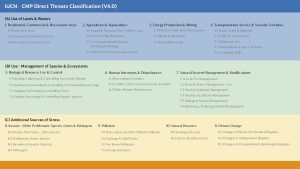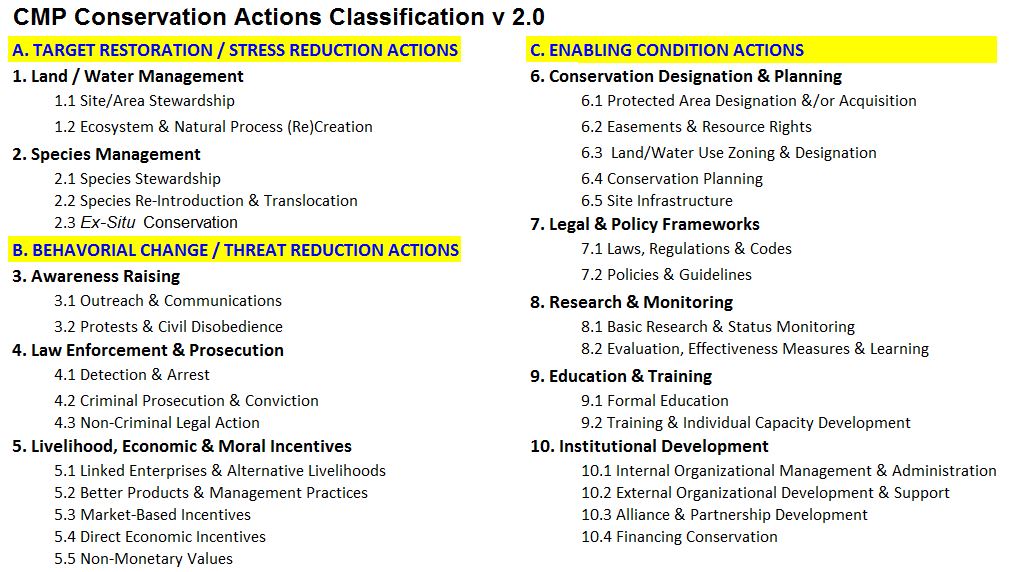A key foundation of any science is a common nomenclature that practitioners can use to describe—in a mutually intelligible way—the problems they are facing and the solutions they are using. For example, if a conservation project team faces the threat of “cattle” and another “grazing” and yet another “beef production,” they may not realize that they are all dealing with the same issue. As a result, cross-project learning is difficult, and the ability to meaningfully roll-up information across projects is greatly hampered.
The taxonomies presented here began with a collaborative effort between the World Conservation Union (IUCN) and CMP to create standard classifications of direct threats and of the conservation actions conservation actors can take to counter them. CMP updated the classifications in June 2016 to incorporate lessons learned and experiences from conservation teams applying Version 1 across hundreds of projects around the globe. In December 2024, IUCN and CMP developed an updated joint Direct Threats Classification, version 4.0. Read more about the classification in Conservation Biology. An updated IUCN-CMP Actions Classification is expected in late 2025 or early 2026.
Threats Classification (Version 4.0, Version 2.0, Version 2.0 en français, Version 1.0)



8 Responses to “Threats and Actions Classifications”
Philippe Lamarre
Hi,
In order to assess more precise threats and identify precise conservation actions, our analysis team at the MFFP (Québec, Canada) has used the level 2 threat list (Version 2.0) to develop a level 3 threat classification. Our level 3 classification is still growing as we analyse different species and we are concerned about the arrival of a possible Version 3.0 of the CMP’s list that would include level 3 threats. Is such a classification being developped on your side? If not, why? If so, could we contribute with our own list?
Thank you for your time and have a great day,
Philippe Lamarre, M. Sc., Biologist, MFFP
dsprod
Thank you Philippe. I will check how this space is being treated. Your classification may be of great use and I will come back to you soon. regards – Daniel (web content manager)
Louise Gratton
I have just downloaded the latest version of Miradi. The Conservation Actions are still the ones from the 2006 version 1.0. Please recommnad that these be upgraded as soon as possible. Thank you.
cstem
Hi Louise – thanks for this comment. I believe the Miradi team is aware of this discrepancy, but best thing is to contact support@miradi.org – that email is actively managed.
Agatha
Hi, I am wondering if the Action Classification are available in French? Thank you.
dsprod
HI Agatha
I am not aware of the classification being available in French. The titles of the actions may be available in the French Miradi ‘help and guidance’ feature.
Joy
Hi there,
I am wondering if this version needs to be updated to the one posted on the IUCN Red List website:
https://www.iucnredlist.org/resources/threat-classification-scheme ?
It states that it is the Threat Classification Version 3.2; however, the pdf to download has a date of Dec 2012, so maybe the one posted here is more up to date?
Any clarification is much appreciated 🙂
dsprod
Hi Joy
The IUCN classification to which you refer is older than the v2.0 presented on this website.
Please have a look at the History explanation in v2.0 for details, but it is generally considered than continued use of v1.0 is suitable where it is fitting in with existing approaches, to retain continuity.
regards Daniel Sprod (web content manager)